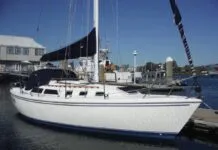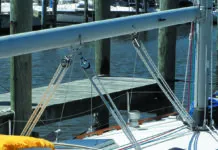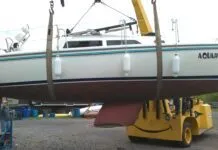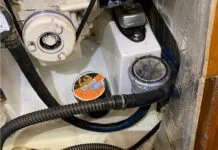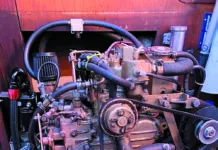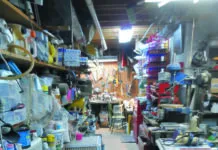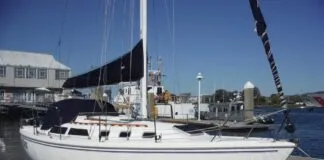
The PDQ 32 is laminated using a modified epoxy resin (AME 5000). Tri-axial knitted fiberglass fabrics are used in the hull and deck. The mast is supported by a carbon-fiber reinforced deck beam. The hulls are solid fiberglass below the waterline and cored with Klegecell foam above the waterline, an arrangement that has proven very durable. Owners have not reported problems with blisters or structural cracking, only limited gelcoat crazing in highly stressed corners. Another PDQ 32 we inspected showed numerous construction shortfalls, including delamination and poor resin wet out, so a thorough survey of any used boat is important.
Each hull has sealed compartments bow and stern (the aft compartments contain the rudder posts), providing a great measure of safety in the event of collision, leak, or holing, and the keels also have sacrificial sections, though we are not aware of any owner that has breached these by grounding.
Vacuum-bagging is used for good bonding and glass-to-resin ratios. There is very little unfinished glass-even in lockers-pieces seem to fit, and there is a general sense of care.
The boat is ruggedly built. Its point of maximum beam, where the top and bottom mold join, is capped by a strong rubrail, and were hesitant to admit how hard weve smacked it against docks, when a strong cross-current surprised us. The transoms are protected by a flange capped with a very heavy, molded-vinyl strip more than 2 inches wide. Its actually hard to give this boat dock rash-and weve really tried.
Good-quality hardware is used throughout. The spar is supported by three 5/16-inch stays plus diamonds. There is no backstay. The stainless-steel chainplates are bolted outside the hulls (the nuts are accessible from the cabin under a removable teak cover), eliminating problems with anaerobic corrosion.
PDQ has given great attention to maintenance access details: The breaker panel is mounted on hinges and supported by a chain when open; finished cabinet doors provide access to steering chains and cockpit instruments; and virtually all cabinets are mounted with a ring of screws on the facing and are easily removed. The need for cutting and boat yoga is very limited.


